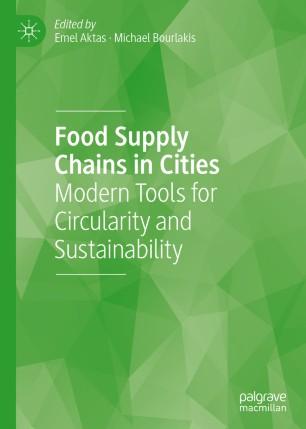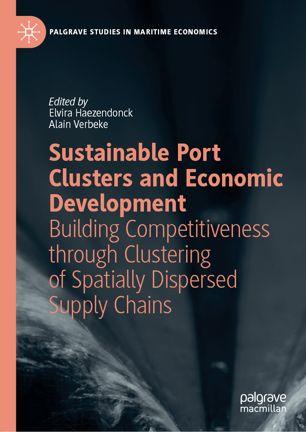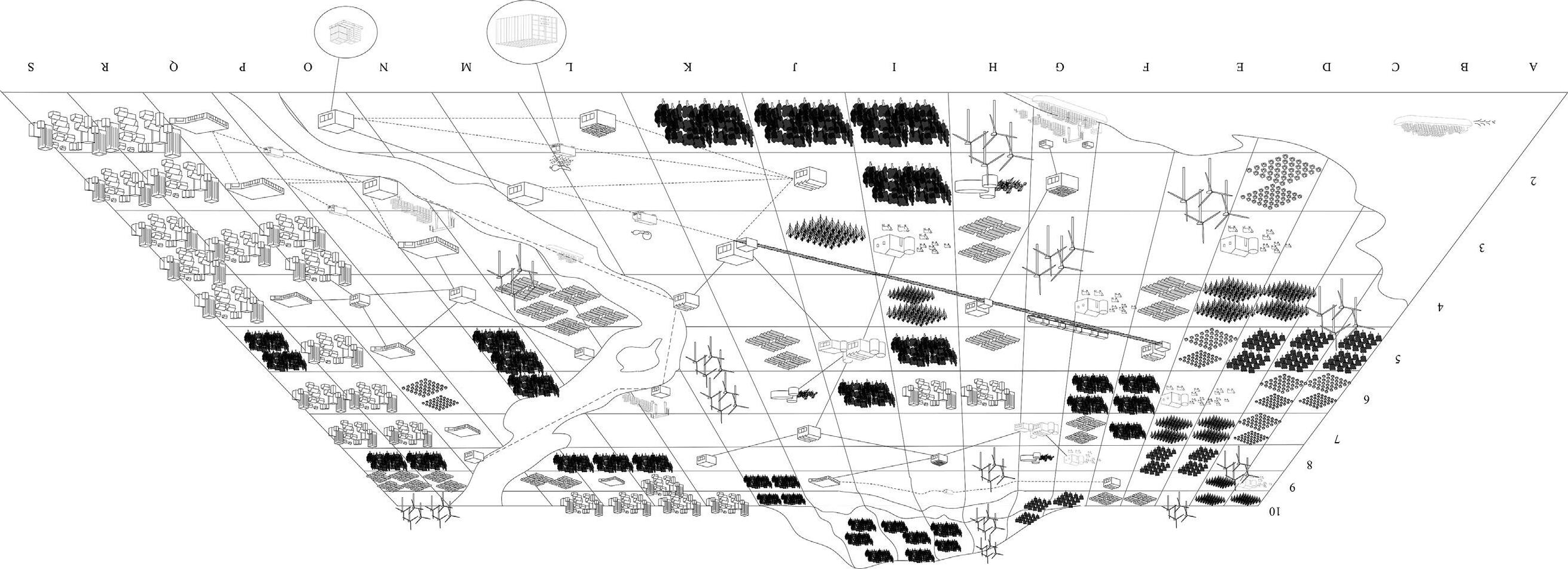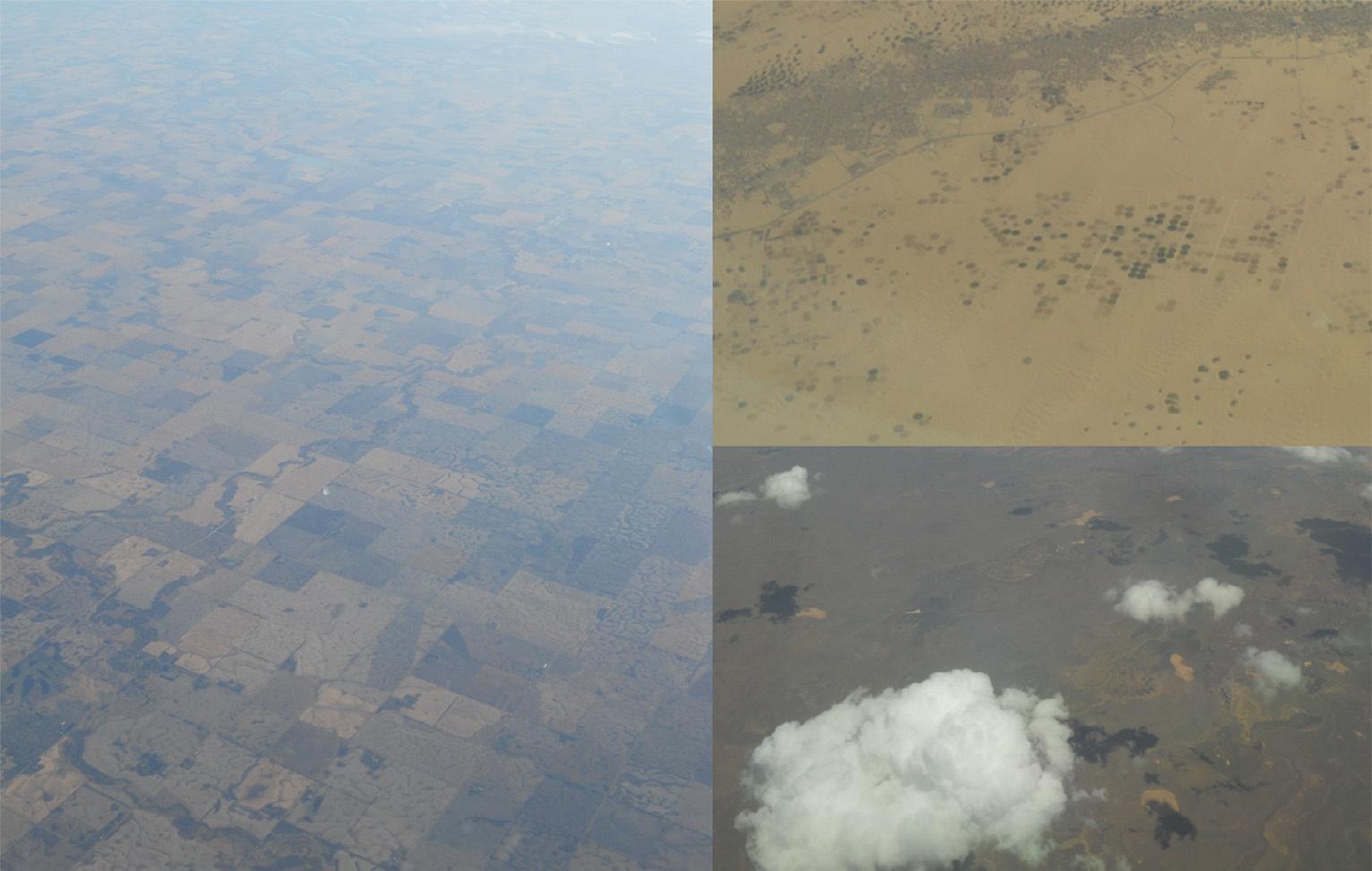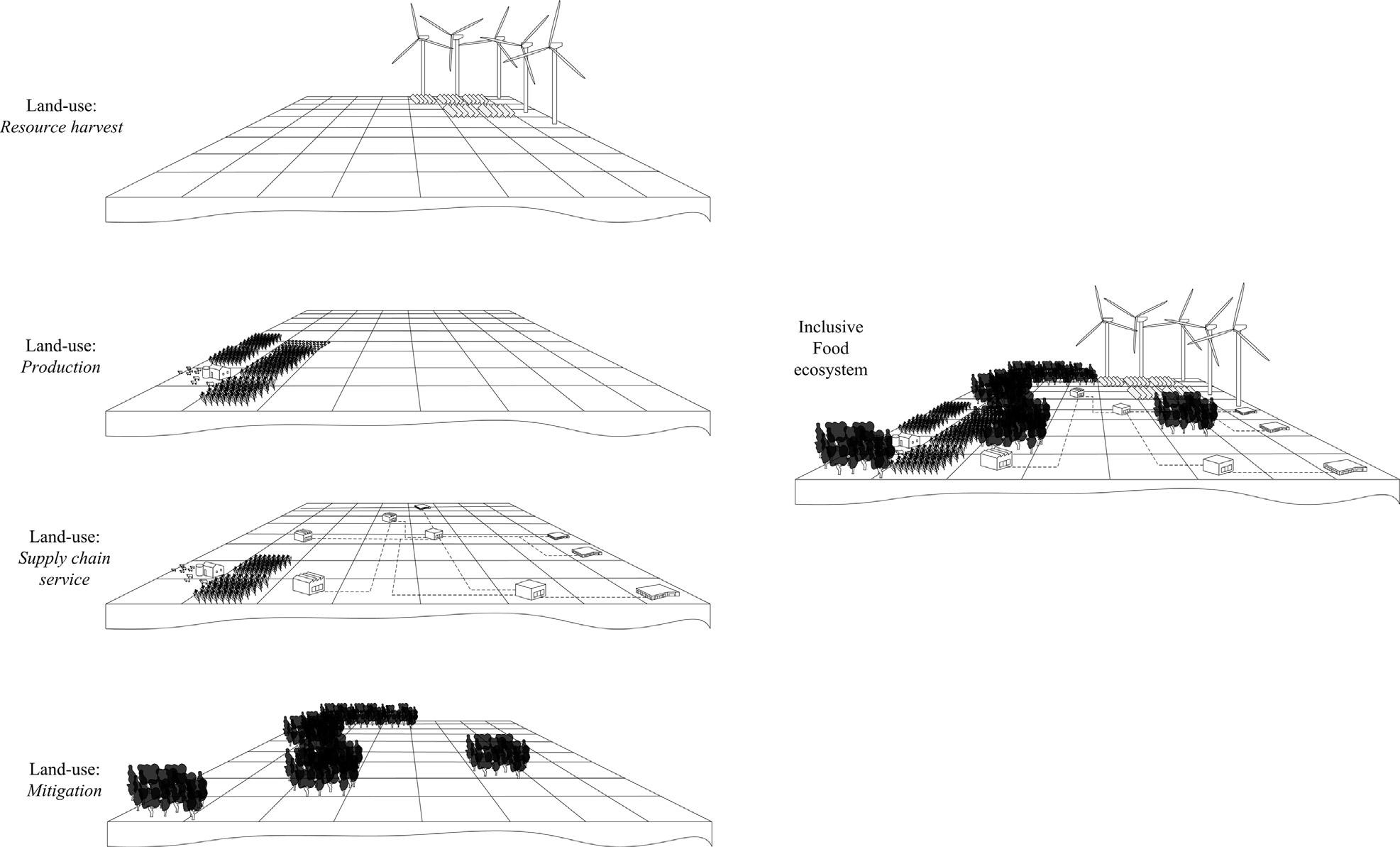Sustainablefoodsupplychains:planning,design, andcontrolthroughinterdisciplinary methodologiesAccorsi
https://ebookmass.com/product/sustainable-food-supplychains-planning-design-and-control-throughinterdisciplinary-methodologies-accorsi/
Instant digital products (PDF, ePub, MOBI) ready for you
Download now and discover formats that fit your needs...
From Linear to Circular Food Supply Chains: Achieving Sustainable Change 1st Edition Stella Despoudi
https://ebookmass.com/product/from-linear-to-circular-food-supplychains-achieving-sustainable-change-1st-edition-stella-despoudi/ ebookmass.com
Food Supply Chains in Cities: Modern Tools for Circularity and Sustainability 1st ed. Edition Emel Aktas
https://ebookmass.com/product/food-supply-chains-in-cities-moderntools-for-circularity-and-sustainability-1st-ed-edition-emel-aktas/
ebookmass.com
Sustainable Port Clusters and Economic Development: Building Competitiveness through Clustering of Spatially Dispersed Supply Chains 1st ed. Edition Elvira Haezendonck
https://ebookmass.com/product/sustainable-port-clusters-and-economicdevelopment-building-competitiveness-through-clustering-of-spatiallydispersed-supply-chains-1st-ed-edition-elvira-haezendonck/ ebookmass.com
Narrating Injustice Survival: Self-medication by Victims of Crime Willem De Lint And Marinella Marmo
https://ebookmass.com/product/narrating-injustice-survival-selfmedication-by-victims-of-crime-willem-de-lint-and-marinella-marmo/ ebookmass.com
Direct liquid fuel cells : fundamentals, advances and technical roadmaps Ay■e Bayrakçeken Yurtcan
https://ebookmass.com/product/direct-liquid-fuel-cells-fundamentalsadvances-and-technical-roadmaps-ayse-bayrakceken-yurtcan/
ebookmass.com
Diversity Intelligence: How to Create a Culture of Inclusion for your Business 1st Edition Heidi R. Andersen
https://ebookmass.com/product/diversity-intelligence-how-to-create-aculture-of-inclusion-for-your-business-1st-edition-heidi-r-andersen/
ebookmass.com
(eBook PDF) Essentials of Marketing 16th Edition by William Perreault
https://ebookmass.com/product/ebook-pdf-essentials-of-marketing-16thedition-by-william-perreault/
ebookmass.com
ROMANCE: BDSM Romance: Raw, Rowdy Rockstar (BBW Contemporary Alpha Male Romance) (Fun, Provocative New Adult Billionaire Steamy Love and Romance Novella) Olivia
Hill
https://ebookmass.com/product/romance-bdsm-romance-raw-rowdy-rockstarbbw-contemporary-alpha-male-romance-fun-provocative-new-adultbillionaire-steamy-love-and-romance-novella-olivia-hill/ ebookmass.com
Perpetuating Advantage. Mechanisms of Structural Injustice
Robert E. Goodin
https://ebookmass.com/product/perpetuating-advantage-mechanisms-ofstructural-injustice-robert-e-goodin/
ebookmass.com
Atlas of Laparoscopic and Robotic Urologic Surgery 3rd
Edition Jay T. Bishoff
https://ebookmass.com/product/atlas-of-laparoscopic-and-roboticurologic-surgery-3rd-edition-jay-t-bishoff/
ebookmass.com
SustainableFoodSupplyChains SustainableFoodSupply Chains Planning,Design,andControlthrough InterdisciplinaryMethodologies Editedby
RiccardoAccorsi
AlmaMaterStudiorum—UniversityofBologna,Bologna,Italy
RiccardoManzini
AlmaMaterStudiorum—UniversityofBologna,Bologna,Italy
AcademicPressisanimprintofElsevier 125LondonWall,LondonEC2Y5AS,UnitedKingdom 525BStreet,Suite1650,SanDiego,CA92101,UnitedStates 50HampshireStreet,5thFloor,Cambridge,MA02139,UnitedStates TheBoulevard,LangfordLane,Kidlington,OxfordOX51GB,UnitedKingdom
©2019ElsevierInc.Allrightsreserved.
Nopartofthispublicationmaybereproducedortransmittedinanyformorbyanymeans,electronicormechanical,includingphotocopying, recording,oranyinformationstorageandretrievalsystem,withoutpermissioninwritingfromthepublisher.Detailsonhowtoseekpermission, furtherinformationaboutthePublisher’spermissionspoliciesandourarrangementswithorganizationssuchastheCopyrightClearanceCenter andtheCopyrightLicensingAgency,canbefoundatourwebsite: www.elsevier.com/permissions
ThisbookandtheindividualcontributionscontainedinitareprotectedundercopyrightbythePublisher(otherthanasmaybenotedherein).
Notices
Knowledgeandbestpracticeinthisfieldareconstantlychanging.Asnewresearchandexperiencebroadenourunderstanding,changesinresearch methods,professionalpractices,ormedicaltreatmentmaybecomenecessary.
Practitionersandresearchersmustalwaysrelyontheirownexperienceandknowledgeinevaluatingandusinganyinformation,methods, compounds,orexperimentsdescribedherein.Inusingsuchinformationormethodstheyshouldbemindfuloftheirownsafetyandthesafetyof others,includingpartiesforwhomtheyhaveaprofessionalresponsibility.
Tothefullestextentofthelaw,neitherthePublishernortheauthors,contributors,oreditors,assumeanyliabilityforanyinjuryand/ordamageto persons orpropertyasamatterofproductsliability,negligenceorotherwise,orfromanyuseoroperationofanymethods,products,instructions,orideas containedinthematerialherein.
LibraryofCongressCataloging-in-PublicationData
AcatalogrecordforthisbookisavailablefromtheLibraryofCongress
BritishLibraryCataloguing-in-PublicationData
AcataloguerecordforthisbookisavailablefromtheBritishLibrary
ISBN978-0-12-813411-5
ForinformationonallAcademicPresspublications visitourwebsiteat https://www.elsevier.com/books-and-journals
Publisher: CharlotteCockle
AcquisitionEditor: MeganBall
EditorialProjectManager: ReddingMorse
ProductionProjectManager: KiruthikaGovindaraju
CoverDesigner: MarkRogers
TypesetbySPiGlobal,India
Contributors RiccardoAccorsi (1,61,83,115,131,145,201,277,293, 305,339,351),DepartmentofIndustrialEngineering, AlmaMaterStudiorum—UniversityofBologna, Bologna,Italy
OmarAhumada (317),AutonomousUniversityof Occident,Culiacan,Mexico
RenzoAkkerman (105),OperationsResearchand LogisticsGroup,WageningenUniversity,Wageningen, TheNetherlands
GiuliaBaruffaldi (115,131,293),DepartmentofIndustrialEngineering,AlmaMaterStudiorum—University ofBologna,Bologna,Italy
KlaraBa ˚ th (219),MicrobiologyandHygiene,RISE ResearchInstitutesofSweden,Gothenburg,Sweden
BehzadBehdani (167),OperationsResearchand Logistics,WageningenUniversity,Wageningen,The Netherlands
RajeevBhat (23),ERAChairforFood(By-)Products ValorizationTechnologies,EstonianUniversityofLife Sciences,Tartu,Estonia
JacquelineM.Bloemhof (159,167),OperationsResearch andLogistics,WageningenUniversity,Wageningen, TheNetherlands
MarcoBortolini (201,305,339),DepartmentofIndustrial Engineering,AlmaMaterStudiorum—Universityof Bologna,Bologna,Italy
LauraBrenes-Peralta (249),DepartmentofAgricultural andFoodSciences,AlmaMaterStudiorum—University ofBologna,Bologna,Italy
ShawnCarver (237),FiddleheadTechnologyInc., Moncton,NB,Canada
FabioDeMenna (249),DepartmentofAgriculturaland FoodSciences,AlmaMaterStudiorum—Universityof Bologna,Bologna,Italy
FerruhErdogdu (83),DepartmentofFoodEngineering, AnkaraUniversity,Ankara,Turkey
YunFan (167),OperationsResearchandLogistics, WageningenUniversity,Wageningen,TheNetherlands
EmilioFerrari (1),DepartmentofIndustrialEngineering, AlmaMaterStudiorum—UniversityofBologna, Bologna,Italy
AndreaGallo (201,339),DepartmentofIndustrialEngineering,AlmaMaterStudiorum—Universityof Bologna,Bologna,Italy
MauroGamberi (305),DepartmentofIndustrialEngineering,AlmaMaterStudiorum—Universityof Bologna,Bologna,Italy
FedericaGarbellini (351),DepartmentofIndustrialEngineering,AlmaMaterStudiorum—UniversityofBologna, Bologna;CAMST—LaRistorazioneItalianaSoc.Coop. Ar.l.,VillanovadiCastenaso,Italy
RodolfoGarcı´a-Flores (261),CSIROData61,Melbourne, VIC,Australia
LauraGarcı´a-Herrero (249),DepartmentofAgricultural andFoodSciences,AlmaMaterStudiorum—University ofBologna,Bologna,Italy
FrancescaGiavolucci (351),DepartmentofIndustrial Engineering,AlmaMaterStudiorum—Universityof Bologna,Bologna,Italy
ZhaneGoff (145),DepartmentofIndustrialandSystems Engineering,NorthernIllinoisUniversity,DeKalb,IL, UnitedStates
MalinGoransson (219),PackagingLogistics,Department ofDesignSciences,LundUniversity,Lund,Sweden
ChristianJames (185),FoodRefrigerationandProcess EngineeringResearchCentre(FRPERC),Grimsby Institute,Grimsby,UnitedKingdom
IviJoudu (23),ERAChairforFood(By-)ProductsValorizationTechnologies,EstonianUniversityofLifeSciences,Tartu,Estonia
PabloJuliano (261),CSIROAgricultureandFood,Melbourne,VIC,Australia
ArgyrisKanellopoulos (159),OperationsResearchand Logistics,WageningenUniversity,Wageningen,The Netherlands
SaraLimbo (49),DepartmentofFood,Environmentaland NutritionalSciences—DeFENS,Universita ` degliStudi diMilano,Milano,Italy
RiccardoManzini (1,115,131,201,293,351), DepartmentofIndustrialEngineering,AlmaMaterStudiorum—UniversityofBologna,Bologna,Italy
HolgerMeinke (39),TasmanianInstituteofAgriculture, UniversityofTasmania,Hobart,TAS,Australia
ChristineNguyen (145),DepartmentofIndustrialand SystemsEngineering,NorthernIllinoisUniversity, DeKalb,IL,UnitedStates
FredrikNilsson (219,293),PackagingLogistics, DepartmentofDesignSciences,LundUniversity,Lund, Sweden
MarcoPagani (249),DepartmentofAgriculturalandFood Sciences,AlmaMaterStudiorum—Universityof Bologna,Bologna,Italy
StefanoPenazzi (277),DepartmentofIndustrialEngineering,AlmaMaterStudiorum—UniversityofBologna, Bologna,Italy;TheLogisticsInstitute,Universityof Hull,Hull,UnitedKingdom
KarolinaPetkovic (261),CSIROManufacturing,Clayton South,VIC,Australia
FotiosPetropoulos (237),SchoolofManagement,UniversityofBath,Bath,UnitedKingdom
LucianoPiergiovanni (49),DepartmentofFood,EnvironmentalandNutritionalSciences—DeFENS,Universita ` degliStudidiMilano,Milano,Italy
FrancescoPilati (131,305),DepartmentofIndustrialEngineering,AlmaMaterStudiorum—UniversityofBologna, Bologna,Italy
DanieleSanti (131),DepartmentofIndustrialEngineering, AlmaMaterStudiorum—UniversityofBologna, Bologna,Italy
FabrizioSarghini (83),DepartmentofAgriculture,UniversityofNaplesFedericoII,Naples,Italy
AndreaSegre ` (249),DepartmentofAgriculturalandFood Sciences,AlmaMaterStudiorum—Universityof Bologna,Bologna,Italy
HelenaM.Stellingwerf (159),OperationsResearchand Logistics,WageningenUniversity,Wageningen,The Netherlands
AlessandroTufano (115,351),DepartmentofIndustrial Engineering,AlmaMaterStudiorum—Universityof Bologna,Bologna,Italy
J.ReneVillalobos (317),InternationalLogisticsandProductivityImprovementLaboratory,ArizonaStateUniversity,Tempe,AZ,UnitedStates
MatteoVittuari (249),DepartmentofAgriculturaland FoodSciences,AlmaMaterStudiorum—Universityof Bologna,Bologna,Italy
LucaVolpe (293),DepartmentofIndustrialEngineering, AlmaMaterStudiorum—UniversityofBologna, Bologna,Italy
Foreword Thesustainableproductionanddistributionoffoodisoneofthemostcrucialproblems,ifnotthedefinitiveproblem,facing theworldtoday.Asourpopulationgrowsandstandardsoflivingrise,humanityisdevelopinganappetiteforfoodstuffs onceenjoyedbyonlyasubsetofwealthyconsumersindevelopednations.Supplychainsforallproductsarebecoming increasinglyfar-flungandcomplex,butthoseassociatedwithfoodmustsupporttheinsatiabledemandofconsumers orderingfromahuge,diversemenunolongerlimitedbylocaleandseason.Seeminglyinsignificantorbenignchoices mayleadtounintendedconsequences,especiallywithrespecttoenvironmentalandsocialissues:whocanforgethowconsumersinNorthAmericaandEuropedevelopingatasteforquinoareportedlyledtoshortagesandpriceincreasesinPeru andBolivia,effectivelyremovingwhatwasalocalnutritionalstaplefromtheplatesofAndeanfarmers?
Perhapswecangetbywithfewerclothesinourclosetsorshopforapparelatsecondhandstores,butthemantraof “reduce,reuse,andrecycle”islessapplicabletonutrition.Asystematicapproachtodesigning,implementing,and monitoringfoodsupplychains(FSCs)isrequired.BolognaisconsideredtheculinarycapitalofItaly,acountryrevered worldwideforitsedibletraditions,soitisappropriatethattheUniversityofBolognaishometotheFoodSupply ChainCenter,whichtakessuchanapproach.ThroughtheirworkattheCenterandtheirnumerouspublicationsandworkshops,Dr.AccorsiandDr.Manzinihavedevotedmuchoftheirprofessionallivestostudyingfoodsupplychainsystems, addressingtheimportantquestionsinacross-disciplinaryandinclusivemanner.Asdocumentedinamyriadofcase studies,theirindustrypartnershipshaveprovidedquantifiablebenefitstocompaniesandcooperativeswithinthefood sector,whiletheiractiverecruitmentandadvisingofstudentsisestablishinganewgenerationofFSCresearchers.
Thisbookrepresentstheirlatesteffortinthefield:theyhavecompiledandeditedtwodozenchapters,startingwiththe designofagriculturalsystemsandfinishingwiththedecisionsupporttoolsforspecificfoodsubsectors.Contributionsfrom expertsspanamultitudeofdisciplinesrangingfromagriculturalsciencetoeconomics.Thesecollectedworksarecurated andorderedtoinformacademicsandpractitionersalikeastohowtoasktherightquestions,useappropriatemodelstomake useofavailabledata,andtranslateresultsintopoliciesandotherrelevantdecisions.
DecisionSciences,SanFranciscoStateUniversity,CollegeofBusiness,SanFrancisco,CA,UnitedStates
SusanCholette
Preface Theideabehindthisbookhasspecificroots:Milan,Julyof2015.TheUniversalExpositionishostedbytheItalian economiccapital,inthenorthofwhatisperhapsthemostrenownedcountryworldwideforfoodtraditionsandindustry. Overa6-monthperiod,morethan140participatingcountriesarecalledtoshowthebestoftheirtechnologyandbestpracticesinordertoofferaconcreteanswertoavitalquestion:howtoguaranteehealthy,safe,quality,andaffordablefoodfor everyone,whilerespectingtheplanetanditsequilibrium.Economicdevelopment,agriculture,energy,andsustainability issuescombinetotitletheExposition’smotto:“FeedingthePlanet,EnergyforLife.”
Thegovernments,citizens,andindustriesoftheentireplanetlookattheExpositionasagreatlearningandsharing opportunity,leadingeachofustoconsiderourselvespartofacommunityandtofacethehardchallengesahead,as Humanity.Foodandwaterwars,food-inducedmigrations,environmentandnaturalresourcesprotections,pollutions, intensiveagriculture,thedebatebetweenorganicversusGMOproducts,andland-usecontrolarejustafewexamples.
Thecentralroleoffoodinthewayweconceive,plan,anddesignoursocietyisthemainfindingoftheExpositionand thisencouragesnewchoicesforcitizens,students,scholarsandresearchers,practitioners,andpolicymakersaswell. Beyondthesecommonhopes,someotherpersonalandprivatepicturesandmemoriesarisefromthatevent.
MycolleaguesandIhadthechancetopresentattheExpositionsomepartsoftheresearchwedevelopedattheFood SupplyChainCenterattheUniversityofBologna(http://foodsupplychain.din.unibo.it/),whichfocusesonthecreationof decision-supporttoolsthataidthedesignofsustainablefoodsupplychain(FSC)operationsfromanindustrialengineering perspective.IntheeraoftheInternetofThings,virtualizationofphysicalprocessesandgamificationofreality,we developedauser-friendlyICTplatformintegratingtheentitiesactiveincommonfoodsupplyecosystemsandvirtualizing theflowsoffoodfromtheagriculturalphases,throughprocessingandtransformation,totheconsumermarket.Thistool (Accorsietal.,2017)aimsatenablingtheusers/plannerstoexperiencetheeffectofadecisiononagivenlinkofthenetwork tothewholefoodecosystem.Suchamethodiscalled gaming,becausetheusers/plannersplaytheleversofthenetworkand experiencetheimpactoftheirchoicesontheoverallsustainabilityoftheFSCasawholeecosystem.Wastegeneration, GHGemissionsgeneratedbyfoodproductionandtransportation,waterandenergyuse,andlaborinvolvementateachstage areaccountedforbythetoolasaresultofthedecisionoftheplanner,andresultsareshownthroughaneasyandcolorful dashboard.
Milan,Expo2015.Ashychild,encouragedbyhismum,playedthe FSCGame withus,simulatingandmeasuringthe impactsofhisdecisionsontheeconomic,environmental,andsocialsustainabilityofafoodecosystem.
That’swhatImostcarriedwithmefromtheUniversalExposition.Nottheshiningexhibitionstands,thehealthyand deliciousfoodswetasted,thespectaculardancesorfireworks,thesolemnspeechesfrompoliticians.Butanenthusiastic childplayingasthe“planneroftomorrow”attheglobalchallengesthathumanitywillhavetotackle:feedingtheplanetina sustainablemanner.
Tolearnfromthislessonandtoeducatenewclassesofplanners,newmultidisciplinarymethodologiesandsystemic approachesfortheplanninganddesignofsustainableFSCsmustbeintroducedandformulated.
Thisbookisintendedtocollectandlinkalonga fil-rouge somemodels,tools,andapproachescomingfromdifferent disciplines(i.e.,agriculturalscience,foodscience,industrialandmanufacturingengineering,operationsresearch,economics,packagingscience,transportationengineering)togetherinvolvedinthedesign,planning,andcontrolofFSCs andfoodecosystems.
Startingfromtheagriculturalsystemsandfollowingthephysicalflowandcycleoffoodalongprocessing,packing, storage,transportation,andconsumption,amodelingapproachisadoptedateachstageinordertoformulatepracticaltaxonomyframeworksandquantitativemodelssupportingaplannerindesign,planning,andcontrolfoodsystemsand operations.
Asaresult,thisbookoffersawideoverviewoftheissuesaffectingFSCsandseekstoprovidepracticalandeffective toolsfortheirmanagement.Givensuchanampleenvironment,therealizationofthisprojectwouldhavebeenimpossible
forusalonetocomplete.Wethusinvolvedanenthusiasticgroupofselectedexperts,whosescientificcontributionsshaped mostoftherecentliteratureinthefield.Aseditors,wespentmostofoureffortsinfillingthegapsamongthetopics,connectingthecontents,andreducingtheoverlapamongchapters.
Thisbookismainlyformasterstudentsandyoungresearchersbelongingtodifferentdisciplines(e.g.,agriculture,engineering,economics,computerscience,ormathematicsfaculties)butalsoformanagersandpractitionersofthefood industryandpolicymakerscalledtorulethesector,oranyonewhowantstobetterunderstandthedecisiondriversbehind thedesign,planning,andcontrolofsustainableFSCs.Wedonotexpecttohavecoveredalltheissuesandaspectsaffecting theagro-foodecosystems,butoureffortswentinthatdirection,andfuturevolumesmightcoverthestillunhandledtopics.
Iwarmlythankallthepeoplewhocontributedtothisproject,whichhasheavilyoccupiedmeoverthelast2years:the coauthorsandchaptercontributors,thecolleaguesoftheFoodandWineSupplyChainCouncil(FWSCC),theclosestcolleaguesandfriendsoftheDepartmentofIndustrialEngineeringatUniversityofBologna,thecompaniesinvolvedinmost oftheresearchprojectsweherebydisseminated,theofficersofthepublishinghouse,andthescholarsandresearcherswho havecontributedinthelastdecadetothestate-of-the-artofthefieldthathasinspiredandmotivateduseverysingleday.
Lastly,Iamgratefultomyfamilyforalltheirsupport,andparticularlytomywife,Debora,forherpatienceforthetimeI stolefromus.Idedicatethisbooktothemwithmuchlove.
Accorsi,R.,Bortolini,M.,Baruffaldi,G.,Pilati,F.,Ferrari,E.,2017.Internet-of-thingsparadigminfoodsupplychainscontrolandmanagement.Proc. Manuf.11,889–895.
RiccardoAccorsi
Sustainablefoodsupplychain:Planning, design,andcontrolthrough interdisciplinarymethodologies RiccardoAccorsiandRiccardoManzini DepartmentofIndustrialEngineering,AlmaMaterStudiorum—UniversityofBologna,Bologna,Italy
Theagro-foodindustryisacentralandleadingsectoroftheworldeconomy(ManziniandAccorsi,2013).Insuchasector thebusinessopportunitiesarewide,asarethechallengestobefacedandtheenvironmentalandsocialexternalitiesto measureandmanage.By2050,fooddemandwillbedoubled,becauseoffurthergrowthoftheworldpopulationandlarger consumptionofanimalfood.Asaconsequence,foodsupplychains(FSCs)areexpandingaccordinglyandproductsare shippedacrosscountriesinvolvingseveralactors,responsibleforprocessing,storage,andtransportationoperations, followingatrendexpectedtoaccelerateinthefuture.TheintensificationofFSCprocessesrequiresinvestigationasto howsustainabletheseare,notjustforpractitionersandcompanies,butalsofortheenvironmentandsocietyasawhole (Accorsi,2019).
Althoughthereisanincreasingfocusofgovernmentsandauthoritiesonthefoodsector,thedesignofsustainableFSCs isindeedfarfromareality(Notarnicolaetal.,2017).Manyconcernsstillaffectthewell-knownthreepillarsofsustainabilityinthefoodsector.Thegreenhousegas(GHG)emissionsfromfoodandbeverageproductionandtransportationand theireffectsonclimatechange(Salaetal.,2017),theexploitationofnaturalresourceslikewaterandsoil(Kummuetal., 2012),thecompetitionforlandbetweenfoodandbiofuels(Rathmannetal.,2010; Fischeretal.,2010a,b; Cobulogluand Buyuktahtakın,2015),theintensiveuseofgeneticallymodifiedorganisms(GMOs),pesticides,andchemicalfertilizersvs. foodorganicmodels(Gerdesetal.,2012; Royetal.,2009; BoyeandArcand,2013; McLaughlinandKinzelback,2015), andthemanagementoffoodwaste(Garroneetal.,2014; LebersorgerandSchneider,2014; Aielloetal.,2014)arejustsome ofthemajorenvironmentalissuesaffectingfoodecosystems.Fromaneconomicperspective,volatileandunaffordable prices,bottlenecksandoperationalinefficiencies,andfoodlosses,aswellasfoodcontaminationandproductcounterfeiting,influencetheprofitabilityoffoodcompaniesandthebenefitsfortheactorsandthestakeholdersthroughoutthe supplychain.Furthermore,foodinsecurityinless-developedcountriesandtheimpactthatconsumers’habitsintherichest countrieshaveontheirownhealthresultsevidentlyinsocialissues,whoseobesityandfooddesert(Thomas,2010; Sadler etal.,2016)areclaimedeffects.
Althoughtheseissuesindependentlyaffecttheenvironmental,economic,andsocialdimensionsofsustainability,they mutuallyarisefromthelackofawarenessofwhatroletheoperationsplaythroughouttheFSCs,ofthewaytheseareimplementedandhowinterdependenttheyare,and,lastly,whichcosts,impacts,andexternalitiesresultfromeachsinglestage andprocessfromfarmtotable.
Whilealargebodyofliteratureindependentlyaddressesthesustainabilityofseveralfoodsupplychainprocessesand operations(Zhuetal.,2018; Accorsietal.,2018a),lessattentionisgiventointerdisciplinarymethodologiesattemptingthe economic,environmental,andsocialsustainabilityofthewholefoodecosystem.
Arisingfromtheassumptionthatlargerandmorecomplexfoodsupplychainsrequireadvancedskillsandmethodsable toembracetheirmultidisciplinarynature,thisbookcollectsmodels,taxonomyframeworks,quantitativemethods,andtools fromseveraldisciplineswithintheextendedfieldofFSCecosystemstoaddressdevelopmentandsustainabilitygoals.
Thisbook,intendedmainlyformasterstudentsandyoungresearchers,foodindustrymanagers,andpolicymakers,is organizedupona fil-rouge thatfollowsthephysicalflowoffoodfromthegrowerstotheconsumers.Thus,itinvolvesthe differentstagesoftheFSCandtreatstheirmainissuesthroughasetofpracticalmodelsandquantitativetoolsthatsupport decisionmaking.Thebookisorganizedinthreeparts:PartAintroducestheissuesaffectingthesustainabilityofFSCsand
definestheboundariesofafoodecosystem;thechaptersofPartBfollowthecycleoffoodfromfarmtoforkandprovide models,methods,andtoolsfortheplanningandmanagementofsuchstages;PartCfocusesonsomesignificantanddiffuse FSCswhoseimpactshavetobeproperlymanaged:fruitsandvegetables,catering,andthemeatindustries.Theoutlineof thisbookissummarizedin Table1
Where Table1 summarizestheissues,problems,andsupplychainphasefocusedonwithineachchapterandclassifies thedisciplinesinvolved, Fig.1 providesaschematicmapofthecontents.Theaimofthismapistoexemplifythephysical flowsoffoodfromfarms/cropstotheconsumers’tables,andtoshowthenumberofactorsinvolved,thenetworkoffacilitiesvisited,andthesetofentitiescontributingsomehowtothefoodecosystem.ThestepsandentitiesoftheFSCare exemplifiedinaschematicwayastheyappearchapterbychapterwhentheassociateddecision-supportmodelsareintroduced.Theauthorsencouragethereadertolookat Fig.1 asabattleshipboardandtoseethereferencestoitsentitiesaccordingly(e.g., G1 – aport).
Chapter1 definestheelementscomposingafoodecosystemthatgoesfromtheruralareastothedemandpoints.By doingthis,italsoformalizesstrategicplanningmodelsintendedforthelocationofsustainableFSCuses,thatis,crops(D2),
TABLE1 Thebookoutline PartChapterGoals
PartA Chapter1 GivesasystemicdefinitionofaninclusiveFoodEcosystemfromthe growers/farmerstotheconsumersandformalizesstrategicmodelsto designsustainableFSCsinvolvingland-useallocationandnetwork infrastructureplanning.
Chapter2 SummarizesthemainissuesaffectingmodernFSCsandprovidesa taxonomyframeworktounderstandthechallengestobefaced.
PartB Chapter3 Providesamodelingframeworkforthemaindecisionproblemsaffecting agriculturalsystems,theirdesign,planning,andcoordination.
Chapter4 Introducesshelf-lifemodelsforthemanagementandcontroloffood processinganddistributionprocesses.
Chapter5 Discussestheroleofpackaginghierarchyinfoodproduct-package systemsandprovidesasupport-designtop-downprocedurefor multidisciplinaryandsustainablefoodpackagingsolutions.
Chapter6 Explorestheroleofadvancedcomputerizedapplications,mathematical models,andvirtualizationinthedesignofinnovativeandsustainable foodprimarypackagesolutions.
Chapter7 Focusingonfoodindustry,providesproductionplanningandscheduling modelstoincreaseefficiencyoffoodprocessingandtoreducelosses.
Chapter8 Focusingonfoodcateringindustry,providesready-to-practicemodelsto aidthedesignofproductionresourcesinafoodjob-shopsystem.
Chapter9 Overviewswhathappensalongstorageoperations,andillustrates modelsandtoolstomanagethewarehousingactivitiesofperishable products.
Chapter10 Introducesdecision-supportmodelsforthedesignoffooddistribution networks,andvehicleroutinganddeliverydispatching.
Chapter11 Focusesontheimpactofvehicleroutingincold-chainswiththeattempt ofimprovingthesustainabilityoffooddeliveries.
Chapter12 Overviewsthemainfoodtransportationsystemsandtechnologieswith practicalexamplesoftheimpactoftemperatures.
Chapter13 Providesataxonomyframeworkforthefoodconservation,refrigeration, andtransportationtechnologies.
Chapter14 Illustrateshowtouseclimate-controlledchamberstosimulatethe impactofenvironmentalstresses,occurringalongstorageand distribution,onthequalityoffoodproducts.
Involveddisciplines
Land-useplanning Operationsmanagement
Agriculturescience Foodscience
Agriculturescience Land-useplanning Operationsmanagement
Foodscience Foodengineering
Industrialengineering
Packagingscience
Packagingscience Mechanicalengineering Foodengineering
Operationsmanagement
Operationsmanagement
Foodscience Operationsmanagement
Operationsmanagement
Operationsmanagement
Operationsmanagement
Transportationscience
Packagingscience Mechanicalengineering
Transportationscience
Foodscience Packagingscience Operationsmanagement
TABLE1 Thebookoutline—cont’d PartChapterGoals
Chapter15 Exemplifiestheadoptionofinformationandcommunicationtechnology (ICT)toolstoimprovethetransparencyofFSCoperationsandthesafety andqualityofdeliveredfood.
Chapter16 Providesforecastingmodelstomanagefooddemandproperlyandavoid losses.
Involveddisciplines
Foodscience
Packagingscience Operationsmanagement
Operationsmanagement Economics
Chapter17 Introducesthetopicoffoodlossesandwastewithataxonomy frameworkthatcoversnewpracticestoimprovesustainabilityofFSCs. Economics Policy
Chapter18 Providesdecision-supportmodelsforthemanagementandreductionof foodlossesalongFSCs.
Chapter19 Dealswiththelogisticsoffoodinurbansystemsandsuggestshowto connectruralareasandconsumersinasustainablemanner.
Chapter20 Focusesonthelogisticsoffoodpackagingandusescomputerizedtools tosupportthedesignofreusablepackagingnetworks.
Chapter21 SustainsthepenetrationofrenewableenergiestopowerFSCfacilities andoperationsbyprovidingastrategicdecision-supportmodelforan integratedsmart-gridandFSCnetwork.
PartC Chapter22 Presentsplanningtoolsforthecontrolandcoordinationofthesupply chainofseasonalproductssuchasfreshfruitsandvegetables.
Chapter23 Focusesonthesustainabilityofthemeatindustryandpresentsatactical decision-supportmodelforthemanagementofwasteandthe valorizationofby-product.
Chapter24 Illustratesthemainissuesofthefoodserviceindustry,andprovidesa support-decisionmethodfortheschedulingandplanningofmeals productionanddelivery.
Operationsmanagement
Land-useplanning Agriculturescience Energymanagement
Packagingscience Operationsmanagement
Land-useplanning Energymanagement Operationsmanagement
Agriculturescience Operationsmanagement
Operationsmanagement
Operationsmanagement
processingfacilities(J2),warehousingfacilities(L1),renewablepowerplants(H1),carbonplantings(I1),andtheallocationofdistributionflowsinbetweenwiththepurposeofmitigatingtheexternalitiesoftheFSC.Itisworthnoting howrenewablesandcarbonplantingsrespondtotheenvironmentalexternalitiesofFSCsastheyenableareductionin theimpactsandmitigatetheassociatedcarbonemissions(Accorsietal.,2016).
While Chapter2 overviewstheissuesandchallengesaffectingtheglobalFSC, Chapter3 focusesonthemainplanning problemsaffectingtheagriculturalsystems(B5-E6).
Chapter4 dealswithmodelsforthecontrolshelflifeandsafetydecayoffoodproductsalongdistributionprocesses, while Chapters5and6 focusontheroleofpackagingandexploreapproachesandmethodologyforthedesignofsustainablefoodpackagingsolutions(L1, 3-O1).
In Chapter7 themanagementandschedulingoffoodprocessingactivitiesintheproductionfacility(J2)areformalized throughanoperationalmathematicalmodel. Chapter8 dealswithtypicalproductionsystems(Q4),knownasfoodjob-shop (Tufanoetal.,2018),designedforthefoodserviceindustrythatserverestaurants,canteens,hospitals,andschools.This chapterintroducesquantitativemethodstoestablishtheadequatenumberofprocessingresourceswithinthefacilitylayout.
Chapter9 concernsthewarehousingactivities(M2)ofperishableproductsandprovidesdecision-supportmodelsand toolsforsafemanagement(seealso Accorsietal.,2018b).
In Chapter10,fooddistributionplanningmodels(J2-N2)areformalizedintermsofvehicleroutingandnetworkdesign problems.
Chapter11 (P2)exemplifiestheimpactofvehicleroutingmodelsonthesustainabilityofthecold-chain. Chapters12and13 overview(e.g., L1, F5, M3)transportationmodesandconservationsystemsusedforthestorageand distributionoffoodproducts.
Chapter14 illustratestheapplicationoftheclimate-controlledchambertosimulatetheimpactofenvironmentalstresses experiencedalongstorageandtransportation(L1, L3)onfoodandpackagequality(Manzinietal.,2017).
Mapofthebook’schapters.
FIG.1
In Chapter15 smartlabelsandotherinformationtechnologytools(L1, O1)areadoptedtoimprovethetransparencyof theFSCandtopreventfoodlosses.
Chapter16 looksattheretailer(Q1-Q2)andconsumers(R1)stagebyprovidingforecastingmodelsintendedforseasonalproductslikefood.
Thepurposeof Chapter17 istodiscussthedriversoffoodlossesandwasteandidentifystrategies,policy,andbehaviors topreventthem.
Tofurthersupporttheminimizationoflossesanddiscardedfood(H2), Chapter18 providestacticaloperationsmanagementmodelstoaidthedistributionoffreshproductsfromcrops(D5)toconsumers(H6).
Chapter19 isintendedtodesignthesustainableconfigurationofarural-urbanecosystem(O6-S10),including renewablefields(R9)andgreenareas(N8),wherefoodisproducedincropsanddeliveredtothecitydwellersbyminimizingtheoverallcarbonemissionsgeneratedbytransportationandmobility.
Chapter20 followsthereverseflowofreusablepackaging(O1)fromtheconsumerstothegrowersandsuggeststheuse ofintermodalitytoreducethecarbonemissionsfromtransportation.
Chapter21 providesstrategicnetworkdesignmodelstofostertheadoptionofrenewables(G3-H3)forpoweringFSC processes.Thelastchaptersfocusonspecificsupplychains.
Chapter22 formalizesmathematicalmodelstobettercoordinateagriculturalandlogisticsoperationsforfreshfruitsand vegetables(B5-E5).
Chapter23 dealswiththevalorizationofby-productsfromthemeatindustry(J5),and Chapter24 discussesthelayout designinjob-shopfacilitiesandthecontrolofrecipe-drivenproductionactivities(Q4)forthefoodcateringindustry.
Despitetheworkscollectedinthisbook,manycellsinthemapof Fig.1 stillneedtobefilledwithnewentities,processes,andrelatedsupport-decisionmethods,belongingtothewidefoodecosystem.Intheend,weleavewillingandcreativereadershopefullyinspiredbythesepagestobuilduponthismapandprovidesuggestionsandtopicsforfuturevolumes andeditions.
References
Accorsi,R.,2019.Planningsustainablefoodsupplychainstomeetgrowingdemands.In:EncyclopediaofFoodSecurityandSustainability.Reference ModuleinFoodSciences.vol.3.Elsevier,pp.45–53. https://doi.org/10.1016/B978-0-08-100596-5.22028-3
Accorsi,R.,Cholette,S.,Manzini,R.,Tufano,A.,2018a.Ahierarchicaldataarchitectureforsustainablefoodsupplychainmanagementandplanning.J. Clean.Prod.203,1039–1054.
Accorsi,R.,Baruffaldi,G.,Manzini,R.,2018b.Pickingefficiencyandstocksafety:abi-objectivestorageassignmentpolicyfortemperature-sensitive products.Comput.Ind.Eng.115,240–252.
Accorsi,R.,Cholette,S.,Manzini,R.,Pini,C.,Penazzi,S.,2016.Theland-networkproblem:ecosystemcarbonbalanceinplanningsustainableagro-food supplychains.J.Clean.Prod.112(1),158–171.
Aiello,G.,Enea,M.,Muriana,C.,2014.Economicbenefitsfromfoodrecoveryattheretailstage:anapplicationtoItalianfoodchains.WasteManag. 34,1306–1316.
Boye,J.I.,Arcand,Y.,2013.Currenttrendsingreentechnologiesinfoodproductionandprocessing.FoodEng.Rev.5(1),1–17.
Cobuloglu,H.I.,Buyuktahtakın,I.E.,2015.Foodvs.biofuel:anoptimizationapproachtothespatio-temporalanalysisofland-usecompetitionandenvironmentalimpacts.Appl.Energy140,418–434.
Fischer,G.,Prieler,S.,vanVelthuizen,H.,Lensink,S.M.,Londo,M.,deWitc,M.,2010b.BiofuelproductionpotentialsinEurope:sustainableuseof cultivatedlandandpastures.PartI:landproductivitypotentials.BiomassBioenergy34,159–172.
Fischer,G.,Prieler,S.,vanVelthuizen,H.,Berndes,G.,Faaij,A.,Londo,M.,deWitc,M.,2010a.BiofuelproductionpotentialsinEurope:sustainableuse ofcultivatedlandandpastures,PartII:landusescenarios.BiomassBioenergy34,173–187.
Garrone,P.,Melacini,M.,Perego,A.,2014.Openingtheblackboxoffoodwastereduction.FoodPolicy46,129–139. Gerdes,L.,Busch,U.,Pecoraro,S.,2012.GMOfinder—aGMOscreeningdatabase.FoodAnal.Methods5,1368–1376.
Kummu,M.,deMoel,H.,Porkka,M.,Siebert,S.,Varis,O.,Ward,P.J.,2012.Lostfood,wastedresources:globalfoodsupplychainlossesandtheir impactsonfreshwater,cropland,andfertilizeruse.Sci.TotalEnviron.438,477–489.
Lebersorger,S.,Schneider,F.,2014.Foodlossratesatthefoodretail,influencingfactorsandreasonsasabasisforwastepreventionmeasures.Waste Manag.34,1911–1919.
Manzini,R.,Accorsi,R.,2013.Thenewconceptualframeworkforfoodsupplychainassessment.J.FoodEng.115(2),251–263.
Manzini,R.,Accorsi,R.,Piana,F.,Regattieri,A.,2017.Acceleratedlifetestingforpackagingdecisionsintheedibleoilsdistribution.FoodPackaging ShelfLife12,114–127.
McLaughlin,D.,Kinzelback,W.,2015.Foodsecurityandsustainableresourcemanagement.WaterResour.Res.51,4966–4985.
Notarnicola,B.,Tassielli,G.,Renzulli,P.A.,Castellani,V.,Sala,S.,2017.EnvironmentalimpactsoffoodconsumptioninEurope.J.Clean.Prod.140(2), 753–765.
Rathmann,R.,Szklo,A.,Schaeffer,R.,2010.Landusecompetitionforproductionoffoodandliquidbiofuels:ananalysisoftheargumentsinthecurrent debate.Renew.Energy35,14–22.
Roy,P.,Nei,D.,Orikasa,T.,Xu,Q.,Okadome,H.,Nakamura,N.,Shiina,T.,2009.Areviewoflifecycleassessment(LCA)onsomefoodproducts.J. FoodEng.90,1–10.
Sadler,R.C.,Gilliland,J.A.,Arku,G.,2016.Theoreticalissuesinthe‘fooddesert’debateandwaysforward.GeoJournal81(3),443–455.
Sala,S.,Assumpcio,A.,McLaren,S.J.,Notarnicola,B.,Saouter,E.,Sonesson,U.,2017.Inquestofreducingtheenvironmentalimpactsoffoodproduction andconsumption.J.Clean.Prod.140(2),387–398.
Thomas,B.J.,2010.Fooddesertsandthesociologyofspace:distancetofoodretailersandfoodinsecurityinanUrbanAmericanneighborhood.World AcademyofScience.Eng.Technol.43,19–28.
Tufano,A.,Accorsi,R.,Garbellini,F.,Manzini,R.,2018.Plantdesignandcontrolinfoodserviceindustry.Amultidisciplinarydecision-supportsystem. Comput.Ind.103,72–85.
Zhu,Z.,Chu,F.,Dolgui,A.,Chu,C.,Zhou,W.,Piramuthu,S.,2018.Recentadvancesandopportunitiesinsustainablefoodsupplychain:amodel-oriented review.Int.J.Prod.Res.56(17),5700–5722.
Chapter1 Modelinginclusivefoodsupplychains towardsustainableecosystemplanning RiccardoAccorsi,EmilioFerrariandRiccardoManzini DepartmentofIndustrialEngineering,AlmaMaterStudiorum—UniversityofBologna,Bologna,Italy
Abstract
Theincreasingglobalfooddemandisforcingthefoodindustrytoidentifyneweffectivestrategiesforproductionanddistribution,aswas alreadyexperiencedinthe1960sand1970swiththebirthofgreenchemistryandtheexplosionoffossil-fueledagriculture.
Theglobalizationofthefoodtradehasbridgedthebarriersbetweenproductionandconsumptionwithoutrespectingthebalanceof naturalresources,resultinginenlargedgapsbetweendevelopedanddevelopingcountries.Inthefoodsectormanyissuesaffectthethree dimensionsofsustainability:economic,environmental,andsocial.Theseincludeland-usechangeanddeforestationtowidenfarms, pastures,andbiofuelcultivations,landgrabbingtoestablishintensiveagriculture,cleanwaterconsumption,soilandairpollution,lack ofsupplychaininfrastructures,volatileprices,andclimatechange.Togethertheseissuesmakecurrentfoodsupplychains(FSCs)unsustainableoverthelongtermandchallengethefutureofthefoodindustriesandsocietyaswell.SuchissuesalsorevealthelackofconnectionsandcoordinationamongactorsinvolvedinFSCsandopendebateabouttheneglectedroleofthephysicalandlogistic/ distributioninfrastructuresinaddressinglong-termsustainabilitytargets.
Thischapterillustratesahierarchicalframeworkaimedatmodelingproductionanddistributionfoodecosystemsthroughasetofinterdisciplinaryparametersanddecisionvariables.Thedecisionleversidentifiedinthisframeworkdescribehowthefoodecosystembehaves accordingtoaninput-outputflowanalysis.Theframeworkformulatesasetofplanningdecisionproblemsviamixedlinearprogramming. Thedefinitionoftheinclusivefoodecosysteminspirescollectingmultidisciplinaryparametersthatimposecollaborationbetween decision-makers.Furthermore,aspartoftheecosystem,logisticsanddistributionprocessesareinvolvedintheplanningissuesbeyond thecommonperceptionthatseesanFSCasasequenceofindependentstages.
1Introduction Foodsystemshaveplayedacentralroleintheprogressofsociety.Early,cropsandfarmsremainedclosetothevillage,as thevillagedwellersworkedthefarmsandtheircropswerethemainsourceofsustenance.Agricultureinfluencedpeople’s well-beingonthebasisofthenaturalresourcesavailable(e.g.,waterenergy,water,fertilesoil)andfavorableclimateconditions(e.g.,regularseasons,mildweather).Inthepast,peoplemigratedtowardfertileecosystemsforlivingandgrowing theirfood(Steel,2008; LeducandVanKann,2013).
Theindustrialandtechnologicalrevolutionofthelasttwocenturiesdeeplychangedoureconomyandtheagriculture sectoraswell.Foodproductionanddistributionprocesseshavegraduallyevolved,poweredbycheapenergysourcesand fossilfuels.Cropsandfarmsenhancedtheiryieldsduetotheadventofgreenchemistry,andnewstorageandtransportation systemsmadefoodcheaper,safer,andmoreaffordable( Jonesetal.,2016; Stephensetal.,2017).Peoplestoppedmigrating towardfertileecosystemsandestablishednewpatternsforfoodproductionanddistributiononalargescale.Namely, peoplestoppedmovingandfoodbegantotravel.
Nowadays,globaltradehasmadesuchpatternsundeniable.Foodisshippedacrosscountriesthroughprocessing, storage,anddistributionoperationsthatentailmultipleactorsandlogisticsnetworks.FSCnetworksrequireadvancedmanagementskillsandnewdecision-supportmodelsandtoolsabletoembracetheirmultidisciplinarynature.
Mostofthedistributionactivitiesworldwidedealwithfoodandenergy(O’Neilletal.,2010).Theglobaltradeallows saferandmoreaffordablefoodtobeprovidedtomanyconsumers,despitetheseasonandareaofconsumption(Govindan, 2018).MatchingsupplyanddemandisconsideredatargetoftheFSC(Apaiahetal.,2005).However,foodinsecuritystill affectsabout15%oftheworldpopulation(FAO,IFAD,andWFP,2012; FAO,2013),whilethelong-termeconomic,environmental,andsocialsustainabilityofthefoodsectorarefarfrombeingadequatelyaddressed.
Inthelastdecade,globalfoodproductionhasgrownexponentiallytosatisfynewmarketslikeIndiaandChina.By2050, theglobalfooddemandwillbedoubled,becauseoffurtherincreasesintheworldpopulationandlargerconsumptionof animalfood(KoningandIttersum,2009)resultingfromchangingfoodhabits.Indevelopedcountries,fooddemandis pushedbyincreasinglymoresophisticatedconsumerexpectations.Asaconsequence,FSCsareexpandingaccordingly withthetrendexpectedtoaccelerateinthefuture(AhumadaandVillalobos,2009; WorldBank,2013).Theintensification ofFSCprocessescausespolicymakersandpractitionerstoquestionwhetherornotthesearesustainablefortheenvironment,notjustforthestakeholdersandcompaniesofthesector.
Scholarsandpolicymakersaredebatingtheimpactthatfoodsystemshaveontheenvironmentandwillhaveinthe future(FAO,2012b).Sofar,onlypartialanswersareavailable.Oneanswerisbasedontheexpectedcontinuingoftechnologicaladvancestoincreasecropyieldsfurther,theoreticallyexpandingthemby80%(PenningdeVriesetal.,1995). Recentliterature,however,suspectsthatsuchanestimatewasoverlyoptimistic,asitdoesnotaccountforthegrowthof urbanareasandthenecessityofwildareastoprotectbiodiversityandareasdevotedtoenergyproduction(i.e.,biofuels). KoningandIttersum(2009) prudentlyreducethisvalueto40%,concludingthatalthoughwehaveenoughsoiltofeedthe planet,theimpactsandtheexternalitiesneedtobequantifiedandassessed.
Theglobalizationofthefoodsectorchangedthemetabolismbetweensocietyandtheenvironment(Loweetal.,2008; Raspor,2008; Notarnicolaetal.,2012; AmateandGonzalezdeMolina,2013).Fromanaturalsourceofsustenance,agriculturebecamearesource-intensiveindustry.Foodoperationsinvolveproduction,packaging,storage,andlogistics,asfor anyotherproduct.TheroleofnonagriculturalactivitiesthroughouttheFSCthusincreasesandseveralindustrialprocesses developinbetweengrowersandconsumers.Theseincludeconsolidatingrawmaterials,foodprocessing,packaging,conservation,distribution,and,lastly,thetreatmentofwasteandlossesthroughrecyclingorvalorizationchains.Thephysical distancebetweengrowingandconsumingareasisproportionaltothenumberofstagesandactorsinvolvedalongthe supplychain.
Suchdistributionnetworksneedinnovativeplanningandmanagementmethodsandtoolsthatenforcethesustainability ofthefoodecosystemasawhole.Thesemethodsmustidentifysustainablepracticesandguidelinesfor:
1. the fairexploitation ofnatural resources,
2. the reduction ofthe human-inducedimpacts ontheenvironment,and
3. the incorporation ofeconomic,environmental,andsocial externalities intheagro-foodindustrydecisions.
Useofnaturalresources,asanexample,mustnotexceedtheregenerationrate(LeducandVanKann,2013; FAO,2012a). Suchpracticeisencouragedevenmorewhenproducingandconsumingareasaredifferent.Theconsumerstypicallyarenot awareofoperationsbeyondthesupplyoffoodandtheenvironmentalandsocialimpactstheseoperationsprovoke.Itisnot uncommon,indeed,thatthenaturalecosystemsofless-developedcountriesareoverstressedtoprovidecheapfoodtothe richestcountries(Tukkeretal.,2008).Globalizationstrengthenstheconnectionsamonggeographicalareasbutaffectsthe overallsustainabilityofglobalecosystems(AmateandGonzalezdeMolina,2013).
Therefore,thequestiontoanswerisnolongerhowtofeedtheplanet,buthowdoitinasustainablemanner.According tothisphilosophy,FSCsneedtobecomenotjustmoreefficientandaffordable,butevenmoresustainableandresilient. Despitetheimplementationofrules,laws,andinternationalagreementsthatpromoteenvironmentallyfriendlypracticein anyindustrialsector(Nilsson,2004; Massoudetal.,2010),thesustainabilityofFSCsisstillanambitiousgoal(Partidario etal.,2007).Manymetricsandindicatorsconfirmthisfact.WhethertheratiooftheenergyconsumedbyFSCoperationsto thenutritionalvalueofsuppliedfoodisametricofsustainability(AmateandGonzalezdeMolina,2013),recentliterature confirmsthatthisparameterhasgrownexponentiallyinthelastdecades(ConfortiandGiampietro,1997; Gallo etal.,2017).
Possiblesolutionslieintheidentificationofthebestcompromisebetweenshort-andlong-termobjectivesbridging togetherdecisionalperspectivesandtargets(Spiertz,2010).Themanagementoftheenvironmentalimpactsintheplanning ofFSCsrequiresfirsttheirquantificationandassessment.Someofthesearemeasuredthroughgreenhousegas(GHG)emissions,soildegradation,energyconsumption,eutrophication,andclimatechange.Thecontributionofeachactorandstageof anFSCtotheseimpactsshouldbeallocatedandquantified.Todothis,anewinclusivedefinitionoftheboundariesofthefood ecosystemsisintroduced. Fig.1 conceptualizestheagro-foodecosystemextendedbeyondthespatialboundaries,and includingagriculture,processing,andpackaging,storageandtransportation,andsomemitigationstrategies.
Accordingtothismodel,widelydiscussedby Accorsietal.(2016a),anFSCisassumedtobeadistributedecosystem aimedatprovidingfoodtoconsumerswhileoptimizingtheavailableresourcesandtheenvironmentalexternalities.The long-termsustainabilityofthisecosystemiscrucialtomeetthegoalsoftheKyotoProtocol(AlmerandWinkler,2017),but requiresjointandintegratedmultidisciplinarytoolsabletoaccountforandincorporateeconomic,technological,organizational,social,andenvironmentalaspectsintothestrategicplanninganddesignofsustainableFSCs.
1.1Scopeofthischapter Thegrowthofglobalfooddemandelicitsdebateonhowtoreconcileeconomicgrowthofthesectorwithenvironmentalsustainability.Newplanningapproachesshould includebothagricultureandsupplychainoperations.Economic,environmentalandsocialtargetsshoulddrivearevolutionarychangeinthemanagementandplanningof foodsystems.Newplanningapproachesaimedtodesignsustainableinclusiveecosystemsshouldbeformulated anddiffusedinpractice.Thesemethodsmaybuilduponexisting techniques,thatis,lifecycleassessment(LCA), whichassesstheimpactsofthefoodlife-cyclefromcroptoconsumer(Accorsietal.,2013).Decisionmakinginfood systemsrequiresstrengtheningtheinteractionbetweenscientificdisciplines(i.e.,agric ulturescience,foodscience, biology,industrial,environmental,andcivilengineering,computerscience,operationsresearch,geography,business andmanagementscience)andadoptingnewquantitativedecision-supporttools, methodologies,and approachesstill lacking( McCown,2002a,b ).
ThischapterillustratesaframeworkthatcollectsstrategicplanningproblemsintendedtodesignanFSCassumedasa closedecosystem.Thescopeistoillustratenewwaystoperceiveafoodsystemandtoaiditsdesign.Theframeworkis organizedthroughatop-downmethodology,whosestepsaresummarizedasfollows:
1. First,itaimsatdrawingthefoodsysteminaquantitativemannerthroughasetofmultidisciplinaryparametersthat describethebehaviorofthesystemandquantifytheavailableresourcesandtheimpactsresultingfromtheir exploitation.
2. Then,itdefinesasetofplanningproblemsthatcanbeformulatedthroughtailoreddecisionvariables.
3. Lastly,itallowstheformulationofmodelsthatquantifybenefitsandexternalitiesofeachchoiceandincorporatebothin theplanningprocess.Itisworthnotingthatthescaleoftheplanningproblemisnolongerlocal,butitovercomesthe spatialboundariesaccordingtotheinclusiveperspectiveillustratedin Fig.1
Whileagricultureisspatiallyconfined,themainprocessesofFSCsaredistributedoverawidegeography.Theplanning problemsadoptedinagriculturedealwiththeland-useallocation,theschedulingofsowing,croppingandharvesting,and themanagementofproductionresources(e.g.,labor,machinery).TheotherFSCprocessesrequiretheprocurementof packagingmaterials,thelocationoffacilities,theproductionplanning,theinventorymanagementofperishableproducts, thedesignandcontrolofstoragesystems,andthestrategic-tacticalplanningoflogistics.
TheintegrationofallFSCstagesreflectsontheintegrationofdecisionproblemsthatarecurrentlysolvedindependently.Theseproblemsareformulatedvialinearandmixedintegerprogrammingascommonlyadoptedinoperations research.However,theplanningproblemscanbeapproachedusingotherquantitativetechniques(e.g.,simulation,data miningandanalytics,machinelearning,empiricalmethods,andanalyticalmethods).
Theframeworkalsosustainsthefulfillmentofnewtargets(e.g.,GHGemissionminimization),incomparisonwiththe traditionalmaximizationofprofitandyields.Furthermore,itlooksattheFSCasawholeandavoidssingle-stage(partial) optimization(LoweandPreckel,2004; LucasandChhajed,2004;see AhumadaandVillalobos,2009 foranextended survey).Theproposedframeworkindeedseeksforminimizingtheexternalitiesfromcroptoconsumer,whileguaranteeing thefulfillmentofthefooddemand.
FIG.1 Inclusivefoodsupplychainecosystem.
Theremainderofthischapterisorganizedasfollows. Section2 describesthemethodologyofanalysis.Aftertheillustrationofthefoodecosystemparameters,examplesofplanningproblemformulationaregiven.Theseexamplesfocuson theminimizationoftheCO2 emissionsresultingfromfoodproductionanddistribution.Thediscussionofthepotential applicationoftheframeworkandtheexpectedbenefitsistreatedin Section3 Section4 concludesthechapterwithaproposalforfuturedevelopments.
2Aframeworktomodelfoodsupplychains Theintensivewaythatagricultureisdevelopedcompelscarefulexploitationofthenaturalresourcesofenergy,soil,and waterandthereductionoftheimpactsandexternalities.Attheactualcurrentrate,theexploitationofnaturalresourcesisno longersustainable.Furthermore,theexternalitiesofFSCsarenotquantified,asabroadanddeepvisibilityintosuchoperationsislacking.Typically,foodcompaniespreferareaswhereproductionconditions,forexample,mildclimateandcheap labor,aremorefavorable,eventhoughitmightleadtooverstressingsomegeographicareas(Meinkeetal.,2009).
Thesupplyofquality,affordable,andenvironmentallyfriendlyfoodisstillahotspotforbothpractitionersandscholars (Spiertz,2010; Brussardetal.,2010).Thereisanurgentneedforintegratedandmultidisciplinaryapproachesabletoshed lightonexternalitiesgeneratedbyfoodsystemsandtosupporttheirminimizationthroughquantitativeapproaches(Luning andMarcelis,2009).ThischapterproposesaframeworkforthedesignofsustainableFSCsthat:
(1) supportstheconceptualmodelingofaninclusivefoodecosystem;
(2) focusesontheminimizationoftheexternalities;
(3) mergestheplanningproblemsofagriculture,production,anddistribution;
(4) fostersamultidisciplinariancollectionofdatatounderstandthefoodecosystemasawhole;
(5) sustainsthedesignofcleaneragricultural,production,anddistributionprocesses.
Thisframeworkintegratesthedesignofthesupplychainnetwork,thatis,foodconsolidation,processing,andstoragefacilities,withtheallocationoflanduses,thatis,functionsofanarea.
LiteratureprovidesseveralFSCdesignmodelsmergingagricultureandlogisticsoperations(AhumadaandVillalobos, 2009).Thesemodelsuseoptimizationtoaidplanningofaspecificstage/process,ratherthantoadoptabroadperspective, mainlybecauseofmodelingandcomputationalcomplexityandlackoflargereal-worlddatasets.Conversely,this frameworkleadstothecollectionandmanipulationofawidesetofparametersbelongingtoagriculture,production, anddistributionfieldsinagreementwithacomprehensiveandreferenceddataarchitecture(Accorsietal.,2018c).
Inordertoleadthedecisionmakerthroughoutdatacollectionandtheformulationoftheplanningproblem,amultistep methodologyissetasfollows:
1. Geographymapping;
2. Agro-climatedatacollection;
3. Settingspatialfunctions;
4. Analyzingpotentials;
5. Modelingagro-foodparks;
6. Modelingagro-foodecosystems.
Descriptionsofeachsteparefoundinthefollowingsections.Theframeworkleadsthedecisionmakeracrossthestrategic planningofanFSC,attemptingtoreachenvironmentalsustainabilityoftheoperationsandtheminimizationofexternalities,whilefulfillingtheexpectedfooddemand.
2.1Geographymapping
Thefirststepdefinesthegeographicalboundariesoftheanalysis.Theplanneridentifiesonthemapareastobecandidates fortheallocationofcrops/orchards/farmsorotherFSCservices.Thescaleoftheareas(e.g.,1ha,10ha)dependsonthe accuracyofthespatialgridandontheavailabilityofspatialdata.Forexample,themeteorologicalstationsspreadovera nationalscalerepresentrobustsourcesofweatherandclimatespatialdata,butsoilpropertieschangefrequentlyoverthe samegrid.Decidingtheproperspatialunittoadoptisindeedcrucial.Thisshouldbereasonablyhomogeneousinitsproperties(e.g.,soilthickness,structure,weather),butnottoosmall,inordertoavoidredundantinstancesandcomputational troubles(Ostendorf,2011).
FIG.2 (A)Leversformappinggeographicareasandallocatingtoaplanningecosystem;(B)Bird’s-eyeviewofruralareasastheywouldappeartoa planner:fromOregon’sskies(left);overNiger(rightabove);somewhereaboveCentralAfrica’sskies(rightbelow).
Fig.2Aillustratesthetwoleversfortheselectionoftheplanningdomain.Thescaleaffectsthesizeofthespatialunit, whilstthehomogeneityindicatesthelevelofsimilaritybetweentheshapeoftheselectedareas.Areaswithdifferentscale andhomogeneitycanbeselected,butneedtobenormalizedintoanewsystemofcoordinates,namely ecosystemcoordinates.Inthisnewreferencesystemthespatialunitisdefinedinagreementwithavailabilityofspatialdataandrouting distanceamongeachunitcalculated.Thisallowsconsideringareasspreadoveralargegeographywithinaplanningecosystemthatbreakthephysicalbarriersofdistance.Theareasinvolvedatthissteparetypicallycleared(i.e.,withoutboth buildingandforests)becausetheywillbeallocatedtonewlanduses.Nevertheless,thehomogeneityofthespatialunitsmay varywithmountains,rivers,andothernaturalbarriers.
2.2Agro-climatedatacollection Thesecondstepisthecollectionofspatialagro-climatedatathatdescribesthecharacteristicsoftheselectedareas.The planningoftheagro-foodecosystementailstheassessmentofthebenefitsresultingfromland-useallocationtotheecosystemareas(Glen,1987; LucasandChhajed,2004).
Indealingwithagriculturalsystems,theliteraturewidelydiscussesthestrategiestomaximizethecropyield,optimize theuseofwater,andminimizetheenvironmentalimpacts(Pacinietal.,2004; AhumadaandVillalobos,2009; Bryanetal., 2011).Otherstudiesprovidepredictionmodelsforcropyields.Thecropyieldisaffectedbytwointerdependentenvironmentaldrivers:thesoilpropertiesandtheweatherconditions(Mathe-Gasparetal.,2005).Agriculture,indeed,isthemost climate-sensitivesector,withoutdoorproductionsensiblyaffectedbytemperatureandprecipitation(CoehloandCosta, 2010).Soilpropertiesspecifytheabilitytoaccept,retain,andtransmitwatertoplants(VanIttersumetal.,2003; Jones etal.,2003).Climateandsoildataseriesareusedtoformulateempiricalmodelsaswellastofuelsimulationmodels (SoltaniandHoogenboom,2007)forcropyieldprediction.Thesemodelstypicallyrequirethevalueofparameterslike temperature,rainfall,airhumidity,windspeed,solarradiation,soiltextureandslopegradient,moisturecharacteristics intheroot,andothers(Schultinketal.,1987),whosecollectionisofteninfeasiblewithoutremotesensingtools;inaddition, accessibledatasetsareavailableonlyforsomecountries.
Notwithstandingpoordataavailability,betterunderstandingastowhichparametersareofinterestandforwhich purposeisoneoftheaimsofthisframework. Fig.3 exemplifiessuchparametersintended,first,topredictthecropyields oftheecosystem’sareas,andthentoassessthepotentialofotherusesoflandlikerenewableenergyproduction(e.g.,solar andwindenergy)ofFSCservices.Throughthedefinitionofthemainparameter,therationaleof Fig.3 anticipateshowthis frameworksupportssynergiesbetweenFSCservices,involvingagricultureanddistributionfacilitiesbutalsorenewables andcarbonplantingsasplanningleverstoachievetheenvironmentalsustainabilityoftheecosystem.
2.3Setspatialfunctions Thisstepaimsatdefiningthealternativespatialfunctions,orland-uses,allocatedtotheareasofthefoodecosystem.The land-useallocationproblemmayconsiderampleopportunities,inagreementwiththeplanningpurpose(Yewlett,2001; Witlox,2005).Thetargetoftheplannergivesafirstinputaboutthedifferentlandusestoconsider:differentcropsand varieties,thesupplychainservices,renewables,etc.Thedemandtofulfillinfluencesthesolutionoftheland-useallocation problem.Forexample,thepresenceoflocalizedordistributeddemanddeterminestheimportanceofsupplychainservices incomparisonwithcropsandagriculturaluses.Theimportanceofhandlingtheland-useproblemalongwiththeplanningof
FIG.3 Agro-climateparametersandpotentialsquantifiedperarea.
sustainableFSCsishighlightedbytheliterature,whichidentifiesland-usechangeandtransportationasthemostsignificant sourcesofairpollution(Desjardinsetal.,2007; OvandoandCaparros,2009).
Thesustainablefoodecosystemisbuiltinthisframeworkuponasetoflandusesthataresomehowinfluencedby weatherandsoil.Thesefourspatialfunctionsareclassifiedasfollows:
1. Productionuse.Thisincludesthespatialfunctionsforprimaryfoodproduction,whichreferstoagricultureandfarming (i.e.,crops,farms,rawfoodpreprocessing).
2. Resourceharvestuse.Thissetprovidestheresourcesneededforproductionanddistributionprocesses(i.e.,renewable energy,watersource).
3. Mitigationuse.Thisspatialfunctionaimsatmitigatingtheexternalitiesgeneratedwithinthefoodecosystem.Examples ofenvironmentalexternalitiesareGHGs,whilepossibleland-intensivemitigationstrategiescanbeplantingstosink carbon,thatis,afforestationprocesses.
4. Supplychainservice.Thissetimplementssupplychainservicesprovidedthroughanetworkofproduction/processing facilities(treatedby Penazzietal.,2017; Tufanoetal.,2018),storagefacilities(discussedin Accorsietal.,2017e),and packagingfacilitiesorotherlogisticnodes.
Byincludingthesespatialfunctionsintoaclosed(butdistributed)ecosystem(Fig.4),theframeworkinvestigatestheinteractionamongruralandgreenareas,renewablesources,andsupplychaininfrastructuresandtheircontributiontogenerate environmentalimpacts.Theresultingland-useallocationprobleminvolvesfurtheraspectsoftheFSCotherthanjustagricultureandisintendedtoconsiderthelandusedasapreciousresourcetomanagecarefully.Nevertheless,itisworthstating that,althoughwelimittheanalysistothoseprocessesrequiringland,otherenvironmentalstressorscanexistinanFSC,for example,fertilizers,farmingsewage,andwateruse(Tilmanetal.,2002; SheerrandMcNeely,2008; Spiertz,2010;Walters andHansen,2012; Notarnicolaetal.,2012).
2.3.1Production Dealingwith production use,twooppositepatternsarediffusedinpractice:intensivevs.organicproduction.Intensive productionadoptsefficientmachineries(Cascinietal.,2013),chemicalnutrientsandfertilizers,enhancingfoodstandardizationthroughbiotechnologyandgeneticallymodifiedorganisms(GMOs)(Brussardetal.,2010).Conversely,organic productionexploitsbiodiversityandorganicfertilizerstosupplysaferandmoresustainableproducts.
FIG.4 Inclusivefoodecosystemservices.
Givenacrop,thesetwopatternscanbeformulatedasalternativelanduses,withdifferentyieldsbutgeneratingdifferent impacts.Theland-useallocationaidedbythisframeworkwillidentifythetrade-offbetweenintensiveandorganicproductionbydesigningsustainableagro-foodproductionparks.
2.3.2Mitigation
The mitigation functionscombinegrazingandgreenareas(i.e.,forest,carbonplantings)responsibleformitigatingand containingtheenvironmentalexternalitiesresultingfromprimaryproductionandfromsupplychainservices.Although bothforestandcropssinkcarbonemissions,forestsrequirelesswaterandrepresentthecheapestsolutiontomitigateglobal warming(Strengersetal.,2008; Westetal.,2010; Seguin,2011; AckermanandStanton,2013).Lastly,themitigationuse oflandgeneratesevenrevenueinthepresenceofcap-and-tradeorcarbontaxregimes.
2.3.3Resourceharvest
Resourceharvest functionsuseareastocollectenergyfromrenewables(i.e.,solar,windenergy,andbiofuels).Suchenergy isusedtocoverthepowerloadrequiredbyprimaryproductionandothersupplychainservices(i.e.,harvesting,irrigation, processing,packaging,storage,transportation)throughoutthefoodecosystem.
2.3.4Supplychainservice
Supplychainservice isobtainedthroughtheallocationofprocessing,packaging,andstoragefacilitiesthatallowconveying foodfromgrowerstoretailers.
2.4Analyzepotentials
Theallocationofsuchlanduseswithinthisinclusiveecosystemenforcesinteractionbetweendifferentspatialfunctions bridgingthegapbetweencosteffectivenessandsustainabilityoftheFSC.Toassessthebestconfigurationoflanduseofthe foodecosystem,thepotentialsofareasneedtobequantified.
2.4.1Cropyield
Dealingwith production use,theapplicationofcropmodelshasalongtraditionintheagronomyandagro-ecologicalliterature(Multschetal.,2011).TheresearchschoolatWageningenUniversitywidelycontributedtodevelopyieldforecastingmodelsstudiedandusedforyears(Boumanetal.,1996).Suchmodelsfindapplicationalsoinland-use planningonlocalandregionalscales(VanIttersumetal.,2003).Acropmodelpredictstheyieldandquantifiesthebenefit oftheland-useallocationproblem,whichcanbesupportedbyquantitativemathematicalformulations.
Mostofthecropmodelsassumesimplifiedconditionssuchashomogeneoussoiltypeandstableweather,andtheytrust theaccuracyofspatialdata.Ahierarchyofgrowingfactorsisstatedbytheliterature(VanIttersumandRabbinge,1997). Thisincludesdefiningfactors(e.g.,carbondioxide,solarradiation,temperature,cropphysiology,phenology,andarchitecture),whichdeterminethenominalproductionassociatedwithstandardconditions;somelimitingfactors(e.g.,water, nutrients),whichdeterminetheeffectiveproductionwithavailableresources;andsomereducingfactors(e.g.,weeds,pests, diseases,pollutants),whichaffecttheexpectedyield.Foracomprehensivetaxonomyofthemostadoptedcropmodels,the authorsreference Jonesetal.(2003)
2.4.2Renewablepotential Dealingwiththe resourceharvest use,weconsidertheenergycollectedbyanareaassumingacoverofrenewableenergy plants.Therenewablepotentialis,forexample,theelectricityfromphotovoltaicsystems(PVs)orwindplant(Savinoetal., 2017).Thecharacteristicsofanarea(i.e.,latitude,longitude,altitude,slopegradient)anditsclimate(i.e.,solarirradiation, windspeed)determinetheenergypotential,whilethecharacteristicsofthesoilconstraintheinstallationofsolarandwind plants.RenewablescanpowerseveralFSCprocesses(i.e.,farming,processing,storage)inasustainablemanner,butcould reducelanddevotedtocrops.Thistrade-offisahotspotofcurrentdebateonbiofuels(KoningandIttersum,2009; Fischer etal.,2010).Theframeworkaddressessuchdebatebycontrollingtheallocationoflanduseinvolvingagriculturaland energysystemsintoauniqueproblem.
2.4.3Mitigationpotential AnexampleofmitigationpotentialistheamountofCO2 anareaisabletoabsorb.Theliteraturewidelydiscussesthe strategiestomitigateGHGemissionsthroughtheadequateuseofland,likecarbonplantings(Smithetal.,2007; OvandoandCaparros,2009).Althoughwithoutincentivesgrowersdonotimplementsuchstrategies,somehiddenbenefits resultfromthesepractices.Theseincludecarbonsequestrationinthesoiltoincreaseyields;theprotectionofbiodiversity, whichreducesthedependenceonpesticides;andtheincreaseoforganicnutrientsinsoilandwater.
2.4.4Supplychainservice The supplychain service(SCS)isprovidedbytheprocessing,packaging,andstoragefacilitythatallowthetransformation anddistributionoffood.Theestablishmentofthesefacilitiesisnottypicallydrivenbytheclimateparameters.Thedesign ofasupplychainnetworkandtheplanningoftheoperationsisledbycosttargetsandinfrastructuralconstraintsthatdonot involveclimateaspects(Accorsietal.,2018b).Nevertheless,theadoptionofclimateparametersisrecommendedtoreduce energyconsumptioninwarehouses(Accorsietal.,2017d,2018a)anddistributionsystems(Galloetal.,2017)andalong deliveryoperations(Accorsietal.,2017a).Areaswithfavorableweather,forexample,orpartiallyexposedtosolarradiationcanbeeffectivecandidatesforwarehousesthatrequirerefrigeratedroomsforperishableproducts.
Whilestillnothandledinplanning,theweatherconditionsalsoaffectthequalityandsafetyofdeliveredfoodand packages,asstatedinrecentliteraturefromtheauthorsofthisvolume(Vallietal.,2013; ManziniandAccorsi,2013; Accorsietal.,2014,2016b; Ayyadetal.,2017; Manzinietal.,2017).Therefore,newplanningpatternsareexpected toassessthepotentialofanareaintermsofsupplychainservice.Forinstance,theSCSpotentialofaspatialunitdecreases asitsdistancefromexistinglogisticinfrastructures(i.e.,ports,distributioncenters,railstations)increases(Accorsietal., 2015b);moreover,theSCSpotentialshoulddecreasewhentheclimateconditionsaffecttheconservationofproductsorthe costforrefrigeration(i.e.,coldchainsinareaswithwarmandhumidclimate).
Thisframeworkusesthequantifiedpotentialstofuelpl anningmodelsthatsolveland-useandnetwork-design problemsabletofulfillagivendemandwhileminimizing theimpactsofthefoodecosystem.Differentpotentials refertodifferentmetricsandinfluencethetargettooptimiz e.Forexample,theequivalent carbonfootprint,thatis, CO2 eq.,whichnormalizestheGHGemissionsgeneratedalongthelifecycleofaprocess/product,canbeusedfor theenvironmentalexterna litiesofafoodecosystem( Wrightetal.,2011).Inordertominimizethecarbonfootprint, mitigationusessuchasrenewables,whichreducetheneedforfossil-fueledenergy,andcarbonplantings,whichsink carbonemissions,canbeconsidered,ratherthanlocatingorganicvs.intensivecrops.The collectedpotentials,varying areabyarea(Fig.5),willdeterminetheoptimalconfigurationofthe ecosystemthatminimiz escosts,togetherwith impactsandusedsoil.
Itisworthnotingthatthenumberofinputparametersincreaseswiththeobservedgeography.Themanagementand manipulationofthisdatacanbesupportedbyarelationaldatabasethatstoresclimate,soil,andothersupplychainrecords intoageographicinformationsystem(GIS).Primarydatapropelspredictingmodels,forexample,cropyieldmodel,in ordertocalculatesecondarydataastheareas’potentials(Witlox,2005; Jonesetal.,2003; Doralswamyetal.,2003, SoltaniandHoogenboom,2007).
2.5Modelingsustainableagro-foodparks Sofar,thestepsofthisframeworkleadtheplannerthroughthedefinitionofthegeographicalboundariesofthefoodecosystem,thecollectionofspatialdata(somereferencedsourcesin FAO,1976,1997,2000),andtheassessmentofthepotentialsbenefitsresultingfromtheallocationofspatialfunctions.
Thisstepaimsatassessingtheenvironmentalimpactsofalternativeagriculturalsystems.Thesearebuiltthroughthe combinationoflandusesforprimaryproduction,forexample,crops,farms.However,otherecosystemservicesasresource harvestandmitigationcanbeinvolvedtominimizethecarbonfootprintofagro-foodpark.
Itisworthnotingthattheproblemofallocatingthespatialfunctionstofulfillagivendemandwhileminimizingthe carbonfootprintoffoodproductionassumestheshapeofatypicaloptimizationproblem (1).
Inequationsystem (1), x isthevectorofdecisionvariablesthatquantifythesurfaceallocatedtoeachspatialfunction; c T isthe transposevectoroflinearcosts(i.e.,inourproblemthecarbonemissionsassociatedwithaspatialunitdevotedtoause); A is thematrixofcoefficientsrepresentingtheweightofvariables x; C isthematrixofcoefficientsrepresentingtheproductivityof variables x; b isthevectorofthesystemcapacities(i.e.,orpotentialsinourframework),and d isthedemandvector.
Theformulation (1) iswell-knownandnotproblem-oriented.Theapplicationofmathematicalprogrammingandoptimizationinagro-foodproductionplanning,particularlyatthefarmlevel,isindeedwidelydiffusedintheliterature(Glen, 1987; AhumadaandVillalobos,2009).Mathematicalprogramminginland-useplanningisusedtoestablishthecombinationoffunctionsthatoptimizeoneormorefunctionssubjecttoaseriesofconstraints(RiveiraandMaseda,2006). Inruralsystems,theoptimizationofcropyields(e.g.,intermsofprofitandcropproductivityaswell)istypicallyconstrainedbythescarcityofresourcesandgrowingfactors(e.g.,land,water,energy).Linearprogramming(LP)andinteger linearprogramming(ILP)modelshavecommonlyappliedalsotoenhancetheeconomicandenvironmentalperformanceof ruralareas.Someoptimizeeconomicandecologicalperformanceindependentlybutlackaninvestigationoftheunderlying relationshipbetweensuchlevers(Pacinietal.,2004).
Byidentifyingthecarbonfootprintasametricofenvironmentalimpact,thisframeworkincorporateseconomicand environmentaltargetsintothestrategicdesignofanagro-foodpark.Twoformulationsoftheproblemaregiven:from abusiness-as-usualmodeltocarbon-drivenmodel.Thefollowingformulationsarebynomeanscomprehensiveor punctual,buttheyhighlightthekeyelementsthattheplanningproblemshouldtakeintoaccount.
FIG.5 Assessmentoflandpotentialsandplanningoflanduse.
Let’sassumethattheproductionofproduct p canbedescribedbyconsideringtwotransformationfunctions(TFs).The firstcalculatesthecropyieldforaspatialunit(characterizedbyspecificclimateandsoilconditions);thesecondquantifies itsimpactintermsofcarbonemissionsgeneratedalongwithseeding,harvesting,fertilizing,irrigation,processing,packaging.Bothfunctionsdependbytheallocationofland l tothefunction/use u,bytheflowofresource r (e.g.,energy, nutrients)exploitedfortheproduction,andbytheproperties(i.e.,climateandsoil)ofland l.Theproblemsets,variables andparametersaredefinedinthefollowing.
Setsandindices:
l 2 L
u 2 U
r 2 R
p 2 P
t 2 T
Setofspatialunits(e.g.,landhectares)involved
Setoflanduses(e.g.,spatialfunctions,crops)
Setofresources(e.g.,ingredients,supplies)
Setofproducts
Setoftransportationordistributionmodes
Fig.6 illustratesthecasewhereagricultureandfoodprocessing/transformationareconsideredasindependentsteps ofFSC.
FIG.6 Business-as-usual productionsystem:agricultureandprocessingareseparatedsteps.
Inagreementwith Fig.6,thetypicaldecisionhandledbygrowersandfarmerscanbeformulatedthroughthevariable (2):
Decisionvariables(2): yrlu
Binaryvariablesare1ifland l allocatedtouse u toproduceresource r;0otherwise.
Thedecisionparametersresultfromthepreviousstep,thatis,primaryclimatesoildata,secondarydataaspotentials,are thefollowing:
Parameters:
Sl(sl1, sl2, sl3, , sln)Agro-climateconditionsofland l
Xpr(Xp1, Xp2, Xp3, , Xpr)Resourcesrequiredfortheproductionofaunitof p
pp 0 (p1, p2, p3, … , pP)Salepricesof P set
cp 0 (c1, c2, c3, , cR)Resourcecosts br
Capacityofresource r
Fpl( Xpr, Sl)ProductionTFofproduct p onland l



